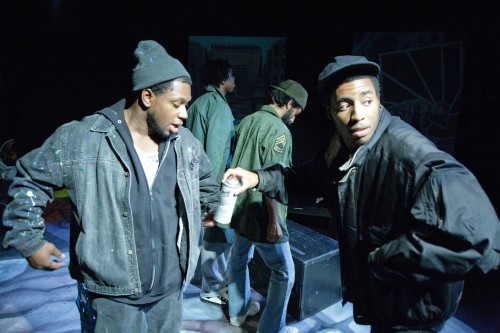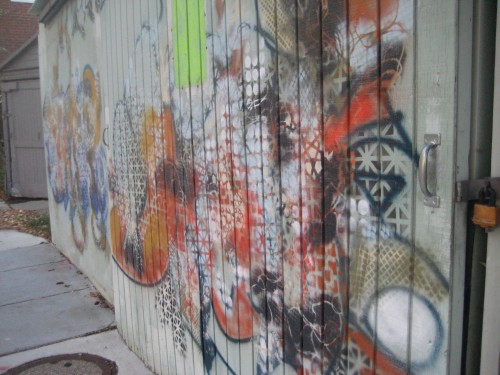Jeff Kirkman III, Alexander Burton, Michael Rodriguez and Stanley Andrew Jackson III; Junesong Arts’ We Fight We Die. Photo by C. Stanley Photography.
Self-defined as representing the masses, it’s no surprise that a majority of Americans approve of the now-global “Occupy” movement—they understand it as the manifestation of desperation, a fight where compromise failed. Feeling powerless in the face of corporate greed and political corruption, hundreds of thousands are venting their anger in the most public, most drastic way possible: by taking to the streets.
But what about those who are neither among the wealthy one percent, nor among the “other ninety-nine”? That is, those truly at the bottom, for whom money-hungry CEOs and rotten Congressmen are perhaps the least of worries; for whom starvation, extreme cold, or gang violence are a much more real threat than losing healthcare or facing foreclosure. Where can they rally? How can they express themselves?
After watching Junesong Arts’ new stage production We Fight We Die, the answer may be that they, too, must occupy the streets…but with aerosol cans instead of pitchforks.
Playing now through November 12th at the Mead Theater Lab at Flashpoint in Chinatown, the show “tells the story of Q, a homeless, virtuosic graffiti artist who has transfixed the local city with his stunning and subversive work,” as goes the press release. Caught by police in the opening scenes, the drama unfolds as Q is forced to choose between jail time and licensing his talent to the local mayor, who has launched a Murals DC-like art program as a PR ploy to win reelection. Assigned the “pathetic” task of painting a local elementary school’s mascot—Unis the Unicorn—Q struggles until the very end with the decision to finish the mural or stay true to his graffiti roots.
At first it seems like a tired plotline, if you’ve followed any of the public debate that has transfixed DC’s street art scene. The CliffsNotes version of the drama: Now in its fifth year, the Murals DC program fills tag-prone spaces with (often urban-styled) commissioned murals, representing a joint effort by the DC Commission on the Arts and Humanities and the Department of Public Works to work with local art organizations and reach a happy medium between vandalism and freedom of expression.
However We Fight We Die freshens up that story through spoken word and a (for the most part) engaging cast of characters, including the brooding, mysterious Q, and his hilarious partner in crime Wits– a fantastic comical and dramatic performance by Stanley Andrew Jackson III. Playwright Timothy J. Guillot—a Catholic University alum inspired by the artwork found along the eastern portion of the Red Line, throws in a number of twists, too: without giving away the ending, the mayor’s viciousness runs so deep it oscillates between despicable and unrealistic. Q himself, we eventually learn, has a sordid past of his own, so terrible that even Wits’ zany humor shrivels in its darkness.
But it is precisely that black or white, extremist edge that makes the play worthwhile: it might be exaggerated, but it gets you thinking. Q makes it clear, for instance, that the essence of his art is anonymity, rebellion and defiance—so clear that, again, you oscillate between rolling your eyes (really? are you going to throw a temper tantrum too?) and thinking that maybe it’s exactly true to reality, a burning need to rectify injustice through revolution. When paired with the mayor’s stunning cruelty, you start to wonder: what can a homeless man, a modern-day “misérable,” do to express himself and fight against the social nets that failed him, the government leaders that ignore him, and the family, friends and neighbors that he doesn’t have? It dawns on you then that of course the streets are his canvas. What other option does he have? By the end, you even consider that, just maybe, until the social injustices that led Q to “criminality” are addressed, the city deserves the (stunning) scarlet letter of his graffiti.
Does DC still deserve its many scarlet letters? Should our city’s walls be occupied?
Freedom of expression (perhaps) at 15th and Fuller Street, NW. A beautiful scarlet letter.


Pingback: canvas crafts